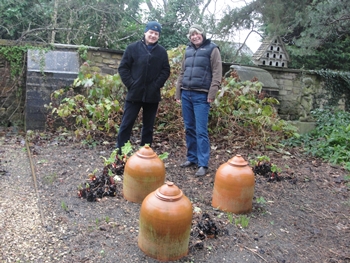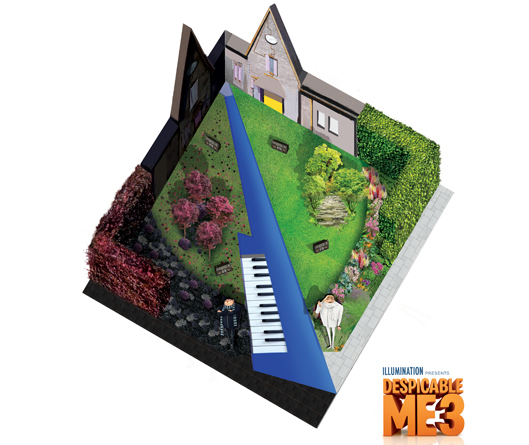
Jane Moore, Head Gardener and ‘Kitchen Garden’ writer, showing me 3 old rhubarb forcers growing dessert ingredients at Bath Priory Hotel, England.
If I had rhubarb crowns in the ground in a south facing part of the garden, I would select a rhubarb crown now and cover it with a black bucket or purpose made ‘rhubarb forcer’ to speed up the growth of some pink early stems.
Alas, my south facing garden is already full, so the rhubarb got planted in the north front garden under the rowan trees, not a very sunny spot. Nontheless, the new green leaves are now sprouting, in spite of the cold. Day length is increasing and life is returning to the garden. However, forcing the rhubarb does put a strain on the plant. In effect, the plant is tricked in to thinking it has been buried deep in the soil as the upturned bucket creates a 24/7 period of darkness. The rhubarb plant reacts by growing faster as it attempts to reach the surface to grow above ground with the arrival of spring. The resulting harvest of pale pink and sweet tasting stems are likely to be the first homegrown fruit of the year. Once a rhubarb plant has been forced, it is as well to leave it for 3 or 4 years before forcing the same plant again, so it gets a few years of normal growth to recover.
The ‘rhubarb forcer’ can be an attractive piece of Victorian – looking garden kit, reminding kitchen gardeners of the realities of food growing in these parts before oil based transport made year round imports a normal part of life. The rhubarb forcer in the 19th century was often earthed up with farmyard manure both to fertilise the rhubarb bed and to insulate the tender rhubarb plant from the harsh early spring weather still holding back growth in the garden.
Whether you impatiently force your rhubarb now or wait for natural growth to occur, now is a good time to cover the soil around the rhubarb plants with compost or well rotted manure.

Trevor is co-founder and was, until his appointment to Government, a board member of Sonairte, the Irish National Ecology Centre, near Julianstown, County Meath which is an Agricultural Training and Visitor centre with a 2.2 acre walled organic garden. He is also a member of Amnesty International, the Dublin Food Co-op, the Irish Organic Farmers’ and Growers’ Association, Organic Trust and a former member of Macra na Feirme. A former teacher and fluent Irish speaker, he relaxes by reading, walking and playing music. His favourite form of relaxation is tending to his prolific organic garden at home in Balbriggan, North County Dublin, an area known by many as Fingal.
Source: Trevor’s Kitchen Garden – Bringing on some Early Rhubarb





